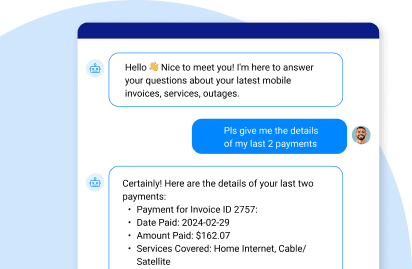What’s keeping you from realizing the full potential of generative AI? The GenAI data gap, of course! It's high time your enterprise had AI-ready data.
From hallucination to precision:
Closing the GenAI data gap with RAG and AI-ready data
Generative AI (GenAI) is a game-changer for customer-centric companies. Those that can leverage Large Language Models (LLMs) effectively are likely to operate more efficiently and competitively. Case in point, generative AI adoption is breaking all records.
One of the biggest obstacles to deploying a customer-facing generative AI app is the reliability of the LLM responses – with a false or misleading answer commonly referred to as an AI hallucination.
Retrieval-Augmented Generation (RAG) is a generative AI framework that has emerged to address this issue, among others. RAG integrates your private data with the publicly available information your LLM has been trained on. The results are more accurate and reliable responses, enhanced customer personalization and intimacy, and significantly fewer hallucinations.
We recently conducted a survey of 300 GenAI professionals indicating that RAG structured data implementation is quite substantial. 12% of the companies surveyed already have RAG projects in production, 60% are piloting the technology, 24% are planning it, and 4% are exploring it.

The current state of RAG adoption
Get our full State of GenAI Data Readiness report for FREE here.
What's causing the gap between GenAI and data?
The survey showed that the largest obstacle in GenAI deployment is cost (51%), followed closely by data security (48%) and LLM response reliability (44%). Another significant challenge is enterprise data readiness (33%), followed by the uncertainties associated with charting a new course.

Challenges in deploying GenAI apps
As you can see, 3 of the top 4 challenges have to do to with your LLM’s ability to leverage your structured data. That's because your enterprise data is scattered across various systems and appears in different formats, and, therefore, difficult to integrate, govern, and access in real time.
Is your enterprise data AI-ready?
No, it's not. Enterprise data isn’t ready for RAG GenAI consumption because:
-
It’s spread across multiple systems
Your organization’s data is typically fragmented across dozens of enterprise systems, such as CRM, customer service, sales, and billing. For instance, providing your LLM with a complete and current view of the customer – while that customer is interacting with a RAG chatbot – requires real-time data integration, master data management, and data quality governance.
-
Real-time access is a must
If, for example, the data for each of your 73 million customers is stored in a central data warehouse or data lake, how can you access all of Casey Garcia’s data in less than a second?
-
Stringent privacy and access controls must be applied
To ensure your sensitive data remains private and secure, user and LLM access must be limited to authorized data only. As per the example above, that means only Casey’s data and nobody else’s. In addition, all Personally Identifiable Information (PII) should appear as masked or anonymized.
You’d also need to consider:
-
Scaling the data infrastructure to support generative AI apps
If all your 48 million customers want to interact with your company chatbot at the same time, could your data infrastructure handle it?
-
Controlling your generative AI costs
At enterprise scale, the cost of building and maintaining GenAI apps plays a critical part in the project’s success. Can you predict the number of LLM API calls required to deal with enterprise-scale GenAI data?
-
Ramping up your prompt engineering expertise
Sophisticated prompt engineering capabilities are needed to generate smart contextual prompts, such as chain-of-thought prompting, to inject the relevant data into the LLM in a way that produces the most meaningful and relevant responses.
Turning your enterprise data into GenAI data
Despite these challenges, your private company data promises to keep your generative AI apps much more honest. With AI-ready data at your beck and call, you can turn your enterprise LLM into a model that knows your business, and more importantly, your customers.
As GenAI evolves, the need to integrate enterprise data continues to be top of mind for leadership teams across the globe. Companies are looking for ways to ensure their data is:
-
Secured and governed
-
Complete and up to date
-
Accessible in real time at massive scale
Discover how the K2view solution
prepares your enterprise data for GenAI use.













